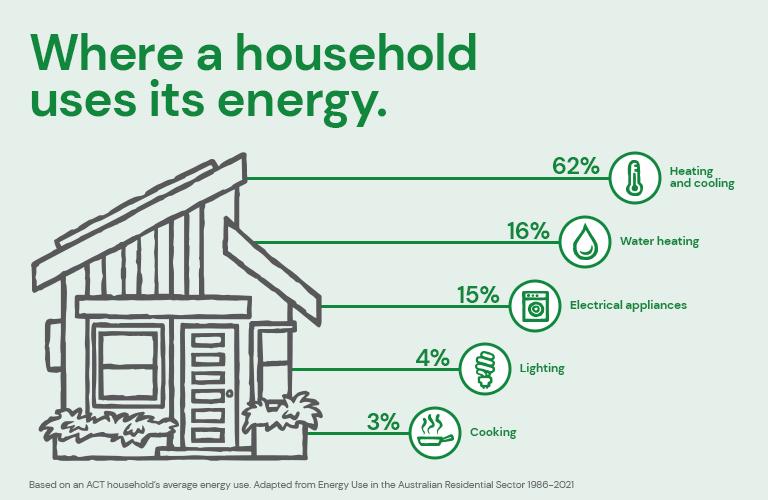All items that use electricity will make their way into your quarterly bill, but some use more energy than others. From smallest to largest, here are the activities and appliances where the average household in the ACT is using their energy.
Put a lid on it
The smallest, but still significant portion of your energy bill, is cooking—but, there are ways to beat a snack attack while reducing your energy use and saving. First up, microwaves use a lot less energy than your stove top or oven—actually, 80% less*. If you can opt to boil water using an electric kettle (rather than on the stove), this is a more energy-efficient option, also.
If the flavours are flying and you are using the stove, putting the lid on your pots and pans can decrease your energy usage by up to 70%*. Just make sure that the lid fits snug in the lip of the pan you’re using. Your meal, with a side of energy savings, is now served.
Switch them off, switch them out
Of course, we’re talking about your lights. Although they only equate to 4% of an average household’s energy, simply switching to more energy-efficient bulbs (with no change to your daily routine) could reduce your lighting costs by up to 88%*. So, let’s go through it.
The easy one: switch them off. Let the sunshine in, turn off your lights when you leave the house (we promise your cat won’t mind) and add motion sensors to areas that aren’t frequently used.
Switch it out: replace those old bulbs. If that’s the light bulb you’ve always bought, branch out to LEDs, fluorescent tubes or the lowest-wattage bulb you can get that will still light the room. Aside from the energy savings, using LED bulbs also last 5–10 times longer than your average halogen bulb*. For further energy savings: switch up your lights. Install light dimmers, find solar-powered alternatives for areas like the garden or porch and use lamps instead of your main lights. Now, those are some bright ideas.
Chilled bills
Moving into the bigger players, 15% of the average household’s energy bill is large electrical appliances. Fridges, freezers, washers and dryers. These are everyday appliances that we all know contribute to our electricity bills, but you may not know exactly how much.
The extra fridge that sits in your garage for just drinks or entertaining could be costing you up to $200 a year, and that’s not including any extra freezers, too.
Similar to your heating and cooling unit, changing the temperature of your appliances will affect your energy usage. Your fridge should be between 3–5°C and your freezer should sit between -15 – -18°C, and every degree lower will use 5% more energy.
Piping hot
A 16% chunk of your energy-usage is attributed to your water heating.
We know the capital region winters can get chilly, but jumping in the shower to warm up isn’t your most energy-efficient option. For an average Aussie household, 70% of the hot water used is used for showers. Dip your toes into the world of energy-efficient shower heads to put yourself in the best position to save, and cut excess hot water where you can, such as washing your clothes in cold washes.
If your water heater is more than 10 years old, it may also be time to consider an upgrade. If you decide to buy a new unit, and moving your water heater is an option, place it as close to your shower as possible. Heat loss, caused by your hot water travelling through lengths of pipes to get to you, will cause you to use more energy to heat the water to your desired temperature.
Hot and cold
Here it is. 62% of an average ACT household’s energy bill is heating and cooling, which is more than all other electricity-powered items in your home, combined. July is the coldest month in the nation’s capital, with the average minimum temperature sitting at an icy 0.2°C^. That’s 4.7°C cooler than the next coldest major city^.
Our legendary winters are worth celebrating, but with temperatures like that, climate control is an important factor in your comfort and well-being.
In winter, aim to keep your thermostat between 18–20°C and be mindful of when you really need your heater on, and when you may just need an extra jumper. Instead of heating your bedroom, consider an electric blanket, a hot water bottle and swap out your cotton pyjamas for warmer materials such as wool or flannel. If you’re looking at purchasing a new unit, or are upgrading, bigger may not always be better. Choose the right-sized unit for the area you need to heat to avoid excess costs, make use of appliance upgrade offers and when your home is warm, lock in the heat! Reduce heat loss by sealing gaps and cracks under doors, around windows and close the doors to any unused rooms.
When those bright summer days return, your thermostat should be set between 25–27°C (and make sure this is on the summer, or cooling, setting). Other than using fans and taking a trip out to the pool every day, the most effective way to stay cool, calm and collected is to stop the heat in the first place. Prevent the sun from hitting your windows and walls with pergolas, outdoor umbrellas, shade sails and shutters. Inside your home, close the blinds or curtains.
If you can, see if you can reduce the length of time that your heater or cooler is on by one hour every day. By the end of the season, you’ll have 90 less hours of heating and cooling costs on your energy bill—utilising the auto-timers built into your system can help you do this, too.

With heating, cooling and water heating accounting for almost four-fifths of your bill, it’s important to minimise the energy usage of these appliances as best you can. Upgrading your inefficient appliances is a great way to reduce your energy use and save more, and with our appliance upgrade offers, you can save money in three ways: a discount off the cost and installation of your new unit, a credit on your quarterly electricity bill as well as ongoing savings due to increased performance and efficiency.
Say good-bye to your power-hungry appliances.
Got an extra fridge that you’re ready to part ways with? Save electricity and a trip to the tip, we’ll pick up your old fridge for free—and we may even give you a $30* credit on your next energy bill, too.
Monitor your usage and compare how your household stacks up against others of a similar size.
Log in to your My.ActewAGL account.
You’ve got the tips and tricks on how to lower your usage, now power up your life admin with the skills for better bills.
How to better manage your energy bills.
References
*www.yourhome.gov.au
^http://www.bom.gov.au/climate/australia/cities



